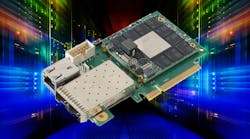SolidRun rolled out the first in a new family of so-called “software-defined” data processing units (DPUs) based on off-the-shelf Arm-based SoCs. It will find homes in everything from cloud data centers to edge devices.
The SolidNET DPU is powered by a general-purpose, 16-nm Layerscape LX2-Lite SoC from NXP outfitted with 16 Cortex-A72 CPU cores that clock at 2.0 GHz. The device is placed on a half-height-half-length (HHHL) PCIe card.
SolidNET allows you to isolate servers from infrastructure based on virtIO, DPDK, NVMe, and other industry standards. Doing so gives you the ability to speed up software-defined networking, security, storage workloads and support application-level acceleration—all for the same cost as a standard smartNIC. SolidRun said DPU can be used to effectively create a server within a server for infrastructure purposes.
NXP’s Layerscape SoC is supplemented with data-path accelerators ideal for packet processing, plus a data compression engine to handle large amounts of data more efficiently. Up to 32 GB of DDR4 memory with error correction code (ECC) can be attached.
The market for infrastructure processors such as DPUs has become one of the biggest battlegrounds in the chip industry, with everyone from AMD and Intel to Marvell and NVIDIA to startups fighting for dominance.
Offloading the CPU
Today, general-purpose CPUs at the heart of a server act as a sort of traffic cop in the data center. They manage networking, storage, cryptography, and other security workloads, all of which primarily run inside software.
These functions have to compete with application workloads for compute, memory, and storage resources, bogging down the CPU at the heart of a server or edge system and impacting performance at the system level.
In general, a DPU is designed to reduce the burden on the server CPU by offloading a wide range of infrastructure jobs to the purpose-built protocol accelerators inside it. With network- and storage-related services offloaded to the DPU, customers can reduce costs in data centers by using more power-efficient network infrastructure hardware.
Where SolidRun’s DPU stands out from others in the category (Intel’s IPUs, Marvell’s Octeon, and NVIDIA’s Bluefield) is that it leverages off-the-shelf Arm SoCs that run networking and storage services in software instead of hardware accelerators.
That means the new DPU runs networking, storage, and security tasks the same way as the CPU it’s offloading. Data traveling through the network is processed by software on the DPU using the Data Plane Development Kit (DPDK). DPDK is a set of standard libraries used to speed packet processing on multicore CPUs. SolidNET also runs software to connect the system to remote or local storage over the NVM Express (NVMe) and NVMe over Fabrics (NVMe-oF) protocols.
While it lacks the hardware-level flexibility of FPGA-based DPUs and the performance of ASIC-based DPUs, SolidRun said SolidNET has the advantage when it comes to power efficiency and access to easy-to-use software. The DPU comes in a power envelope that consumes less than 25 W (40 W maximum), giving it enough power efficiency to be packed densely in cloud data centers and even deployed out on the edge.
The company also uses the Layerscape LX2-Lite SoC, which supports dual 25-GB/s Ethernet (GbE) ports and a single 1-GbE port for management, in a family of system-on-modules (SOMs) for embedded systems.
Multi-Vendor Series
Today, many of the infrastructure processors on the market are targeted at cloud data centers that have a unique set of hardware requirements. But the new series of software-defined DPUs promises to bring more flexibility to the table. SolidNET can offload infrastructure chores that are frequently used in the cloud as well as workloads that are more specific to the edge—from cybersecurity stacks to application firewalls.
SolidRun said anyone using the software-defined DPU can take advantage of the vast software ecosystem that surrounds Arm. It thus gives them the flexibility to optimize performance or add new features over time.
As it runs separately from the system’s host CPU, the SolidNET DPU boots to Linux or other general-purpose operating systems. NXP’s LX2-Lite leverages eight lanes of PCIe Gen 3 as its standard connectivity interface.
The strict isolation between the host CPU and the DPU offloading it has a host of other advantages. Security is improved with independent out-of-band management capabilities, secure boot, and root-of-trust support.
"A DPU provides an effective way to drive more efficient resource utilization and reduce operating costs throughout the data center," said Imran Yusuf, head of hardware ecosystem in Arm’s infrastructure division.
SolidRun is positioning SolidNET as a multi-vendor solution that will support a wide range of off-the-shelf Arm-based SoCs. According to the company, it plans to announce additional SoC options in the future.
